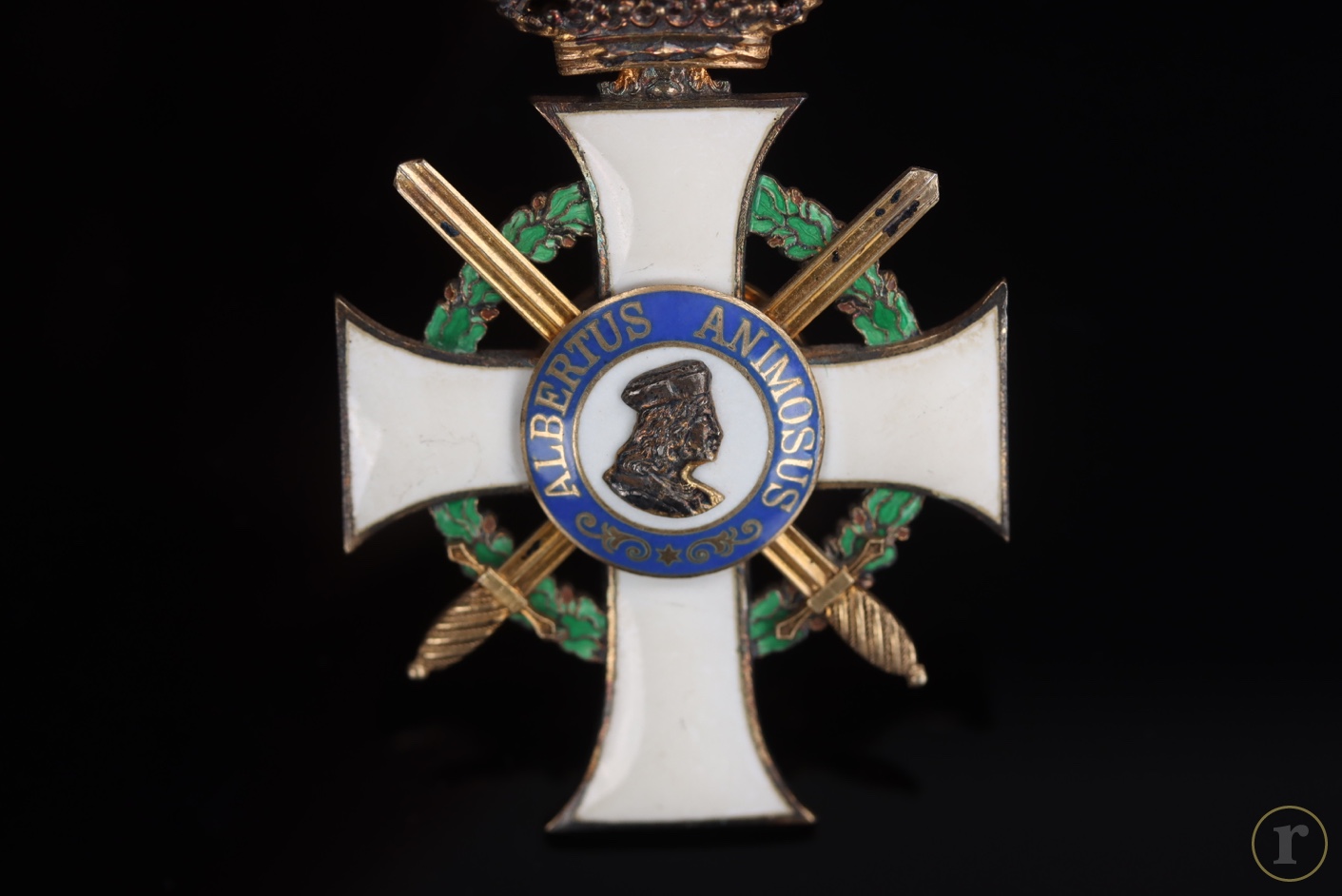NEW UPDATE - JULY 2023
Buy treasures for a reduced Buyer‘s Premium
Königreich Sachsen Order of Albert 2nd Pattern 1876 - 1918, younger Head Knight's Cross 1st Class with Crown and Swords

Königreich Sachsen Order of Albert 2nd Pattern 1876 - 1918, younger Head Knight's Cross 1st Class with Crown and Swords
Own a similar product you want to sell? We are here for you at +49 8541 9053699
-
MEDALNET APPRAISAL SERVICES
-
MEDALNET APPRAISAL SERVICES
MEDALNETSERVICES.COMThis item was examined and validated in cooperation with MEDALNET APPRAISAL SERVICES. Our team’s knowledge base received the most competent boost for orders and decorations for imperial orders and decorations with the help of Bernd Kruse and Andreas M. Schulze Ising. Andreas and Bernd are held in high regard with collectors around the world. With more than 50 years of experience in the field of order decorations and medals, they are seen as competent and independent experts.
GUARANTEEAs usual, we offer a full right of return for originality within the withdrawal period for items that are offered in cooperation with MEDALNET APPRAISAL SERVICES.
MEDALNET APPRAISAL SERVICES
-
-
PAYMENT
-
HOW CAN I PAY FOR MY ORDER?
AUCTIONSYou will receive an e-mail confirming your successful bids the day after the auction has ended. In your personal my ratisbon's you will be able to inform us about your most convenient payment method for this order or tell us about an alternative shipping address.
If we don’t hear from you within 24 hours, we will send an invoice choosing the payment and shipping options which we think are the most comfortable ones to you. If you decide to change your shipping or payment method after receiving your invoice, just drop us a line or visit my ratisbon's/ORDERS for any more details.
SHOP ORDERSChoose your payment method when ordering and submit your order. Once your order has been received we will send an invoice including your shipping costs and your payment instructions.
After receiving the invoice, the order must be paid within 7 days.
Please contact us to discuss layaway options.To learn more about paying at ratisbon's, please see your FAQ pages.
WE ACCEPT FOLLOWING PAYMENT METHODS
-
-
Versand
-
HOW DO YOU SHIP MY NEW TREASURES?
PACKING & TRACKINGWe usually send out orders within 1-3 working days after your payment has been received. In most cases, we are faster than this! We will inform you when your goods are being dispatched and provide a tracking number, In addition, you can always check your order status at my ratisbon's/ORDERS. Delivery times will vary depending upon the delivery destination and type of shipping service you have chosen.
SHIPPING TO ALTERNATIVE ADDRESSIf you prefer to have your order shipped to your work address or a friend during your absence, we will happy to arrange this for you. Send us an email letting us know about your new shipping address and we will be happy to send an updated invoice to you.
OUR LOGISTIC PARTNERS ARE AS FOLLOWS
-
-
OUR GUARANTEE
-
 OUR GUARANTEE!
OUR GUARANTEE!We only offer collectables which to the best of our specialists knowledge are authentic. About 15% of all consignments are returned to the consignor after extensive research due to authenticity issues.
Unlike traditional auction houses we do offer a full right of return. If you are not satisfied with what you won or bought, you may return it within 14 days. Please inform us and we will instruct you on how to return the goods. For more information, please visit FAQ pages.
Important note: Cancelling bids after an auction may disappoint the consignor, who like you is a collector. This situation is easy to avoid. We encourage you not to bid on any collectable if you are unsure if it fits into your collection. Ask us to cancel your bid 24 hours prior to the end of an auction to avoid this situation.
-
COUNTRY Imperial Germany
DIMENSIONS
WEIGHT
EAN 2000000716244
PERIOD until 1918
COUNTRY Imperial Germany
MATERIAL silver
DIMENSIONS
MAKER
WEIGHT
COUNTRY Imperial Germany
LOT K-8359
DIMENSIONS
EAN 2000000716244
MAKER
WEIGHT
Königreich Sachsen Order of Albert 2nd Pattern 1876 - 1918, younger Head Knight's Cross 1st Class with Crown and Swords
Description
Saxony Kingdom, Order of Albrecht 2nd Model 1876 - 1918, younger head Knight's Cross 1st Class with Crown and Swords. Material silver and enamel, on original ribbon section. Old patina, no enamel damage. Untouched, beautiful specimen.
Condition
1-2
December 31, 1850, the Abert Order was created by King Friedrich August of Saxony. The main purpose of establishing the Albert Order was to honor those partaking in the revolts of 1848/49. Everybody that served meritorious, virtuous in civilian life, in science and art was eligible to receive this order. The order was named after Albert the Courageous as founder of the Albertinian Line from the House of Wettin to honor his death anniversary of 350 years.
Initially, there were five classes: a) Grand Cross (Großkreuz), Commander Cross 1st Class (Komturkreuz 1. Klasse), Commander Cross 2nd Class (Komturkreuz 2. Klasse), Knight Cross (Ritterkreuz) and Small Cross (Kleinkreuz). Those classes provided the basis for a series of changes made over the whole existence of this order. The cross was designed as a christian cross in gold with white enamel showing a oak leaf wreath through the arms of the cross and surmounted by a crown in case of Grand Cross and Commander. The Medallion is white enameled with the bust of the former ruler (two types) and encircled by a golden blue enameled ring showing the orders motto: “Albertus Animosus” terminated on the bottom with a floral agraf. The reverse medaillon is white enameled as well with the saxon coat of arms attached. The blue medallion ring shows a floral design being terminated on the bottom with the year of its foundation: 1850. The four (Grand Commander) and eight (grand cross) pointed star shows the same medaillon in the middle as the cross.
On March 18, 1858, the Small Cross was renamed to Honour Cross (Ehrenkreuz). On March 26, 1861 the gold and the silver Albert Medal (Verdienstmedaille) was added. In conjunction with the war of 1866 swords were added on 29th of October. On December 9, 1870 the Swords on Ring followed for those a) receiving a decoration with swords to an already received identical class without swords or b) those that received a civil upgrade to an existing military award (for example a) being awarded a knight cross with swords to an existing knight cross without swords or b) being awarded a Commander Cross 2nd Class without swords over a knight cross with swords).
Finally on January 26, 1875, it became apparent that the Albert Order had been awarded for 25 years with the wrong ancestral bust and was corrected quietly. Instead of Albert the Courageous Johan the Consistent had been shown by mistake, worse, being even from the Ernestine lineage.
1876, possibly based on the above mentioned mistake, the statues of the order were extensively overhauled. On February 2, 1876, the Knights Cross was split into two classes, the knight cross 1st class and the knight cross 2nd class. Further, the Honor Cross was abandoned and could be traded for the newly created knight cross 2nd class. In addition the golden and silver Albert medal were dropped from the lineup and no longer awarded; recipients of the golden medal were allowed to trade for the newly created Albert Cross (Albrechtskreuz). All classes would be awarded with and without swords from now on.
From April 30, 1883, on, the golden star to the Grand Cross was added and awarded on the sash of the House Order of the Crown of Rue framed in two white stripes. This was changed on April 21, 1893, when the golden star could be awarded on special occasions on the regular Albert Order sash.
Already June 11, 1890, the Officers Cross (Offizierskreuz) was added, ranking between the Knight Cross 1st class and the Commander Cross 2nd class, followed by the establishment of the Knight Cross 1st Class with golden Crown on July 26, 1901.
The Silver Crown was added to the golden star of the Grand Cross on August 24, 1903, creating the highest grade of the Albert Order.
On January 18, 1907, clarity was finally given to the Swords on Ring. Saxony followed the mainstream rule, when Swords on Ring were shown upgrading an existing military decoration with swords to the next higher class awarded for civil merit without swords.








